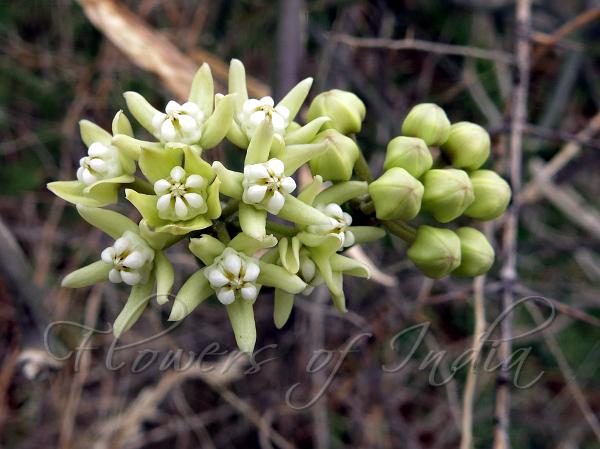|
| Leafless East-Indian Vine |
|

|

| File size | 645901 |
| Original date | 6/19/17 9:43 AM |
| Resolution | 2048 x 1536 |
| Flash | Flash did not fire, auto |
| Focal length | 6.1mm |
| Exposure time | 1/250s |
| Aperture | 5.6 |
| Focus Distance | |
| Metering Mode | Multi-segment |
| Camera make | Canon |
| Camera model | Canon PowerShot G15 |
| Sensor type | OneChipColorArea |
|
|
|
|
Photo: |
Botanical name: Cynanchum acidum Family: Apocynaceae (Oleander family)
Synonyms: Sarcostemma acidum, Asclepias acida, Sarcostemma brevistigma
Synonyms: Sarcostemma acidum, Asclepias acida, Sarcostemma brevistigma
Leafless East-Indian Vine is a climber with stems
up to 2 m long,, twining, green or gray, hairless. Flower cymes are
borne at branch ends or in axils, 6-15-flowered, about 1 × 2 cm,
carried on 3-5 mm long stalks. Sepals are ovate, about 1 mm, margin
translucent. Flowers are white or yellowish, petals ovate-oblong or
oblong-lanceshaped, about 3 × 1 mm, hairless. Outer corona is
shallowly cupular, inner lobes obtuse, slightly shorter than or as long
as anthers. Seed-pods are lanceshaped in outline, round in
cross-secion. about 15 × 1 cm. Seeds are broadly ovate, about 3 × 2
mm. Leafless East-Indian Vine is found in seashore thickets in India,
Myanmar, Nepal, Thailand, Vietnam and China.
Flowering: March-November.
Medicinal uses:  In Siddha medicine system, this plant is used in treatment of
respiratory ailments like mild bronchospasms,allergic rhinitis,
sinusitis, coryza or common cold.
In Siddha medicine system, this plant is used in treatment of
respiratory ailments like mild bronchospasms,allergic rhinitis,
sinusitis, coryza or common cold.
 In Siddha medicine system, this plant is used in treatment of
respiratory ailments like mild bronchospasms,allergic rhinitis,
sinusitis, coryza or common cold.
In Siddha medicine system, this plant is used in treatment of
respiratory ailments like mild bronchospasms,allergic rhinitis,
sinusitis, coryza or common cold. | Identification credit: N. Arun Kumar | Photographed in Karnataka. |
• Is this flower misidentified? If yes,